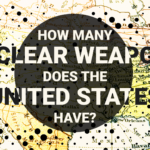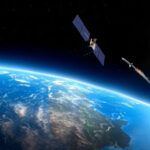Trump apparently wants a nuclear test. It could be bad for your health.
By Sara Z. Kutchesfahani | June 5, 2020
In recent weeks, the Trump administration reportedly discussed the possibility of doing something the United States has not done since 1992: resuming explosive testing of nuclear weapons. Since the creation of the nuclear bomb, at least eight nations have detonated 2,056 nuclear test explosions at test sites around the world. Ten years ago, Japanese artist Isao Hashimoto created an informative but scary time-lapse map depicting all of these explosions. In it, each nation gets a flashing dot on the map whenever it detonates a nuclear weapon, with a running tally kept on the top and bottom bars of the screen. While the story begins in 1945 with the first ever nuclear weapon test (code-named Trinity), the real action comes in 1962, when there were 178 tests globally, more than in any other year. Not only is the rapid rate alarming, but where they happened—mainly on the lands of indigenous people—is also shocking.
A US resumption of nuclear tests would send a bad signal to other countries and prompt them to test and create their own nuclear weapons. Moreover, innocent bystanders could be exposed to the radioactive fallout from a nuclear explosion. Tens of thousands of people have been afflicted by leukemia, thyroid cancer, miscarriages, and severe birth defects as a result of past nuclear testing in the United States alone.
Half of the 2,056 nuclear tests were conducted by one country alone: the United States. Yes, that’s right: the total number of US-conducted tests stands at 1,030, which is more than the number of tests done by the other seven nuclear testing countries combined. Most of the explosions took place at the height of the Cold War in a series of tit-for-tat exchanges between the United States and the Soviet Union.
Even before the banner year of 1962, nuclear testing was already out of control. In 1954, the United States carried out Castle Bravo, the most powerful US nuclear weapon test (and its first thermonuclear weapon, also known as an H-bomb). The 1961 Soviet Tsar Bomba (“King of Bombs”) detonation, though, remains the most powerful human-made explosion in history. Tsar Bomba created an explosion equivalent to 50 megatons of TNT. Let’s pause for a moment for a mathematical intermission to put this yield into perspective.
1 ton = 1,000 kilograms, or 2,200 pounds of explosives
1 kiloton = 1,000 tons, or about 2,200,000 pounds
1 megaton = 1,000,000 tons, or about 2,200,000,000 pounds
The biggest conventional bomb in the US arsenal = 11 tons of TNT
Little Boy (Hiroshima) = 16 kilotons of TNT
Fat Man (Nagasaki) = 20 kilotons of TNT
Castle Bravo = 15 megatons of TNT (roughly 1,000 times more powerful than the Little Boy bomb)
Tsar Bomba = 50 megatons of TNT (roughly 10 times the total explosive power unleashed in all of World War Two, including both the Little Boy and Fat Man bombs that destroyed Hiroshima and Nagasaki)
Each and every above-ground nuclear explosion spread radioactive materials throughout the atmosphere. Once the Partial Nuclear Test Ban Treaty took effect in 1963, many of the tests moved underground, but those still sometimes leaked radioactive materials into the atmosphere. The overall effect was the contamination of the air and soil where people live and work—some of which is still around today.
While testing continued throughout the Cold War, it came to a gradual halt by 1992, such that by 1993, negotiations for a Comprehensive Nuclear Test Ban Treaty began. The Comprehensive Test Ban Treaty is an international treaty banning all nuclear explosions for both civilian and military purposes, in all environments, but it has yet to enter into force. Although the United States has not ratified the treaty, it and all other nuclear weapon states (apart from North Korea), have honored the test ban. Perhaps maybe until now.
Why should the average person care about all this? Well, because there was and is an enormous human cost of nuclear weapons testing. If you go back and watch the Hashimoto video, you’ll notice none of the 1,030 US tests were conducted anywhere near Washington, DC. Likewise, none of the Soviet, French, or British tests were carried out around Moscow, Paris, or London. Instead, the explosions took place mainly on the lands of indigenous people, such as in the Marshall Islands, or in some cases, in the country’s own backyard, such as in New Mexico, Colorado, and Nevada.
Nuclear testing ignores the voices of those who are tangibly affected by it. The human cost of nuclear weapons testing, from environmental contamination to the exploitation of powerless communities, has largely been overlooked. When the United Sates opened a nuclear testing site near Las Vegas, the people who lived downwind of the test site were assured that only a safe level of radiation could reach them. Yet, sheep started getting sick. They had burns on their faces and lips and blisters on their bodies. Ewes miscarried. Many lambs were born deformed or too weak to nurse. Around 20,000 sheep in total—a quarter of the herds in southern Utah and Nevada—died.
If that was the effect on sheep, imagine the effect on humans. Cancers associated with radiation exposure (including leukemia and thyroid cancer) were all too common. Women suffered from miscarriages. Those who didn’t miscarry gave birth to babies with severe birth defects, some of which were so severe that the infants didn’t look human. In 1990, US Congress created the Radiation Exposure Compensation Act to help rectify these injustices. To date, over 36,000 people have claimed benefits from the fund, giving a sense of the scale of the harm. But this is a lower limit. An independent study has estimated that radiation from testing caused more than 340,000 excess American deaths between 1951 and 1973.
The harms are not just a thing of the past: Utah “downwinders” are still suffering and dying as a result of health effects from nuclear tests conducted upwind in Nevada decades ago. One such downwinder is Mary Dickson, who has seen friends and family die of cancer, and has even had her own battles with it. In 2007, she wrote Exposed—an unpublished screenplay based on a true story about her sister, a fellow downwinder, and her deteriorating health due to the effects of the above-ground nuclear tests.
I’ve had the privilege of reading Exposed, and it is superb. Dickson pieces together the historical nuclear nuggets in such a compelling way that it not only deserves a thorough and careful read, but also a viewing, with tissues at hand. It is extremely powerful and personal, so much that anyone reading or watching it would be outraged by the Trump administration’s latest proclamations to resume nuclear testing. (The Players Club in New York had planned to stage a reading of the play in May 2020 on the sidelines of the Nuclear Non-Proliferation Treaty Review Conference, but unfortunately these plans were put on hold due to the coronavirus pandemic.) One of the most dramatic lines of the play reads, “The hardest thing is not the dying. It’s that the dead are so easily forgotten. We’re fighting for all of them. So their lives will serve as a warning. So it won’t happen again.”
Together, we make the world safer.
The Bulletin elevates expert voices above the noise. But as an independent nonprofit organization, our operations depend on the support of readers like you. Help us continue to deliver quality journalism that holds leaders accountable. Your support of our work at any level is important. In return, we promise our coverage will be understandable, influential, vigilant, solution-oriented, and fair-minded. Together we can make a difference.
Keywords: Comprehensive Nuclear Test Ban Treaty, downwinders, nuclear testing
Topics: Columnists, Nuclear Weapons














